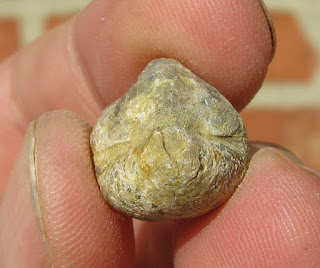Another Composita species that I found in the Chainman formation of Utah is Composita elongata. This species is narrower than some but this particular specimen has a very strong fold and sulcus that is well developed. According to MacKenzie (see below for reference), C. elongata may intergrade with C. subtilita (see previous post). This means that the two species sometimes share the same form but remain distinct.
I used the reference "Brachiopoda of the Amsden Formation (Mississippian and Pennsylvanian) of Wyoming.", MacKenzie Gordon, Jr., 1975 pg. 64, plate 10, fig 16-25 to identify this brachiopod.This specimen came from Conger Springs west of Delta, Utah and is Carboniferous (Mississippian epoch, Visean stage of the ICS or Mississippian period, Chesterian stage in the US) in age.
Pedicle valve
Anterior
Brachial valve
Posterior
Profile (with pedicle valve on top)
Profile (with brachial valve on top)
I used the reference "Brachiopoda of the Amsden Formation (Mississippian and Pennsylvanian) of Wyoming.", MacKenzie Gordon, Jr., 1975 pg. 64, plate 10, fig 16-25 to identify this brachiopod.






No comments:
Post a Comment